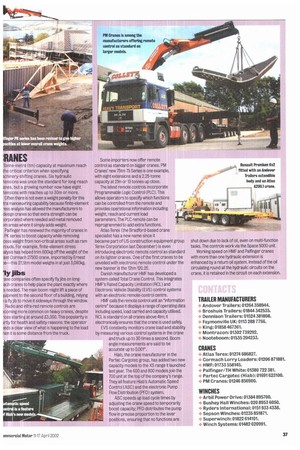:RANES
Page 37

If you've noticed an error in this article please click here to report it so we can fix it.
Tonne-metre (tm) capacity at maximum reach the critical criterion when specifying ichinery-shifting cranes. Six hydraulic tensions was once the standard for long-reach anes, but a growing number now have eight tensions with reaches up to 30m or more. Often there is not even a weight penalty for this tra manoeuvring capability because finite-element tess analysis has allowed the manufacturers to design cranes so that extra strength can be ;orporated where needed and metal removed )m areas where it simply adds weight.
Palfinger has renewed the majority of cranes in PK series to boost capacity while removing cess weight from non-critical areas such as ram muds. For example, finite-element stress ialysis has helped trim 600g off the weight of the 4St Cormach 27500 crane, imported by Ernest )e—this 27.5trn model weighs in at just 3,080kg.
ly jibs
'am; companies often specify fly jibs on long ach cranes to help place the plant exactly where S needed. The main boom might lift a piece of luipment to the second floor of a building, relying
fly jib to move it sideways through the window. Radio and infra-red remote controls am ;coming more common on heavy cranes, despite -ices starting at around £3,000. This popularity is krtly for health and safety reasons: the operator !eds a clear view of what is happening to the load hen it is some distance from the truck.
Some importers now offer remote control as standard on bigger cranes. PM Cranes' new 75tm 75 Series is one example, with eight extensions and a 2.25-tonne capacity at 21m or 13 tonnes up close.
The latest remote controls incorporate Programmable Logic Control (PLC). This allows operators to specify which functions can be controlled from the remote and provides operational information including weight, reach and current load parameters. The PLC remote can be reprogrammed to add extra functions.
Atlas-Terex (the Bradford-based crane specialist has a new name since it became part of US construction equipment group Terex Corporation last December) is even introducing electronic remote control as standard on its lighter cranes. One of the first cranes to be unveiled with electronic remote control under the new banner is the 12tm 120.2E.
Danish manufacturer HMF has developed a system called Total Crane Control. This integrates HMF's Rated Capacity Limitation (RCL) and Electronic Vehicle Stability (EVS) control systems with an electronic remote-control centre.
HMF calls the remote control unit an "information centre" because it displays a range of operating data including speed, load carried and capacity utilised. RCL is standard on all cranes above 4tm; it electronically ensures that the crane is used safely.
EVS constantly monitors crane load and stability by measuring various control systems in the crane and truck up to 30 times a second. Boom angle measurements are said to be accurate up to 0.0010.
Hiab, the crane manufacturer in the Partec Cargotec group, has added two new capacity models to the XS range it launched last year. The 600 and BOO models join the 700 unit at the top of the company's range. They all feature I-Ilan Automatic Speed Control (ASC) and the electronic Pump Flow Distribution (PFD) system.
ASC speeds up load cycle times by adjusting the crane speed to temporarily boost capacity; PFD distributes the pump flow in precise proportion to the lever positions, ensuring that no functions are shut down due to lack of oil, even on multi-function tasks. The controls work via the Space 5000 unit.
Working speed on HMF and Palfinger cranes with more than one hydraulic extension is enhanced by a return oil system. Instead of the oil circulating round all the hydraulic circuits on the crane, it is retained in the circuit on each extension.






















































































































































